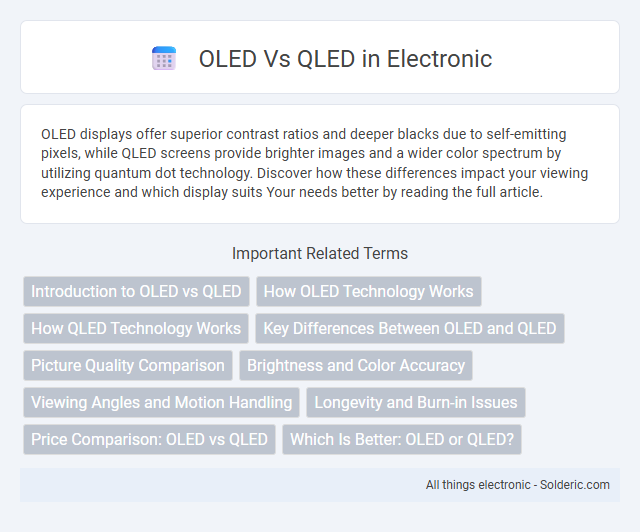OLED displays offer superior contrast ratios and deeper blacks due to self-emitting pixels, while QLED screens provide brighter images and a wider color spectrum by utilizing quantum dot technology. Discover how these differences impact your viewing experience and which display suits Your needs better by reading the full article.
Comparison Table
| Feature | OLED | QLED |
|---|---|---|
| Technology | Organic Light Emitting Diodes | Quantum Dot LED |
| Black Levels | Perfect blacks due to individual pixel lighting | Deep blacks but with slight light bleed |
| Brightness | Lower peak brightness | Higher peak brightness suitable for bright rooms |
| Color Accuracy | Excellent, true-to-life colors | Vibrant colors with quantum dot enhancement |
| Viewing Angles | Wide viewing angles with minimal color shift | Limited viewing angles, color shifts at extremes |
| Response Time | Fast response time ideal for gaming | Slower than OLED, but adequate for most uses |
| Lifespan | Shorter lifespan, potential burn-in issues | Longer lifespan, no burn-in risk |
| Price | Generally more expensive | More affordable, especially in larger sizes |
Introduction to OLED vs QLED
OLED technology features organic light-emitting diodes that produce true blacks and vibrant colors by emitting light individually from each pixel, enhancing contrast and energy efficiency. QLED utilizes quantum dot technology to improve brightness and color accuracy through a backlit LCD panel, resulting in vivid and sharp images suitable for well-lit environments. Both technologies offer distinct advantages in display performance, with OLED excelling in contrast and QLED in brightness and color volume.
How OLED Technology Works
OLED technology operates by using organic compounds that emit light when an electric current passes through them, enabling each pixel to produce its own light independently. This self-emissive property allows OLED displays to achieve true blacks and infinite contrast ratios since pixels can be completely turned off. The layers of organic materials are sandwiched between two electrodes, with light generated directly within the panel, resulting in thinner, more flexible screens compared to QLEDs which rely on backlighting.
How QLED Technology Works
QLED technology uses quantum dots to enhance LED backlighting, emitting precise colors through a layer of semiconductor nanocrystals. This process increases brightness and color accuracy, making QLED displays ideal for well-lit environments. The quantum dot layer improves energy efficiency by converting light into pure, saturated hues, resulting in vibrant images with high dynamic range.
Key Differences Between OLED and QLED
OLED displays use organic light-emitting diodes that produce individual pixels emitting their own light, resulting in perfect black levels and superior contrast. QLED screens rely on a quantum dot layer combined with LED backlighting, offering higher brightness and vibrant colors ideal for well-lit rooms. Your choice depends on preferences for contrast and black depth (OLED) versus brightness and color volume (QLED).
Picture Quality Comparison
OLED displays deliver superior picture quality with true blacks and infinite contrast due to self-emissive pixels that turn off completely, enhancing color accuracy and depth. QLED screens, equipped with quantum dot technology, offer brighter images and vibrant colors, excelling in well-lit environments but often struggle to achieve the same contrast levels as OLED. HDR performance favors OLED for its ability to render fine details in dark scenes, while QLED's peak brightness benefits highlight visibility in bright scenes.
Brightness and Color Accuracy
OLED displays excel in color accuracy with perfect black levels and vibrant hues due to their self-emissive pixels, providing enhanced contrast in dark scenes. QLED technology delivers superior brightness, making it ideal for well-lit environments and ensuring vivid colors even under strong ambient light. Your choice depends on whether you prioritize deep, precise colors (OLED) or higher luminance for bright settings (QLED).
Viewing Angles and Motion Handling
OLED displays offer superior viewing angles due to their self-emissive pixels, maintaining consistent color accuracy and contrast even at wide angles, unlike QLED screens which rely on backlighting and may exhibit color shift and diminished contrast. In motion handling, OLED panels generally perform better with faster pixel response times, reducing motion blur and providing smoother motion during fast-moving scenes compared to QLED technology. These characteristics make OLED ideal for immersive viewing experiences in diverse settings and dynamic content.
Longevity and Burn-in Issues
OLED displays offer superior contrast and color accuracy but are more prone to burn-in and shorter lifespan due to organic material degradation. QLED screens use quantum dot technology with LED backlighting, providing longer durability and resistance to burn-in, making them ideal for prolonged use. Your choice depends on whether you prioritize vivid picture quality or extended device longevity without worry of image retention.
Price Comparison: OLED vs QLED
OLED TVs generally command higher prices due to their advanced self-emissive technology offering superior contrast and deeper blacks. QLED models, leveraging quantum dot technology with LED backlighting, tend to be more affordable and provide brighter displays suitable for well-lit rooms. Consumers seeking premium picture quality often invest in OLEDs despite the cost, while budget-conscious buyers may prefer QLED for a balance of performance and price.
Which Is Better: OLED or QLED?
OLED displays offer superior contrast ratios and deeper blacks thanks to their self-emissive pixels, making them ideal for dark-room viewing and cinematic experiences. QLED screens excel in brightness levels and color volume, providing vibrant images suitable for well-lit environments and gaming. Your choice depends on whether you prioritize rich blacks and viewing angles (OLED) or high brightness and color intensity (QLED).
OLED vs QLED Infographic

 solderic.com
solderic.com